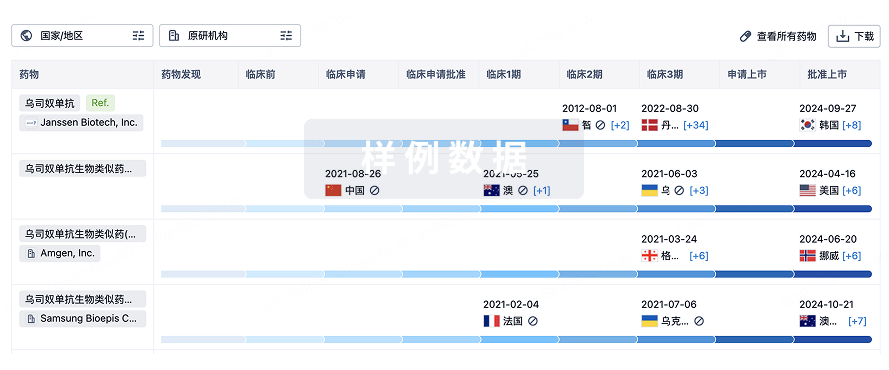预约演示
更新于:2025-09-20
PPI-1019
更新于:2025-09-20
概要
基本信息
原研机构 |
在研机构- |
权益机构- |
最高研发阶段无进展临床1/2期 |
首次获批日期- |
最高研发阶段(中国)- |
特殊审评- |
登录后查看时间轴
结构/序列
分子式C36H54N6O5 |
InChIKeyTUSUWHFYKZZRIG-JQWMYKLHSA-N |
CAS号290828-45-4 |
Sequence Code 13764991

关联
2
项与 PPI-1019 相关的临床试验NCT00100334
Multiple Dose Safety and Preliminary Pharmacodynamic Study of PPI-1019 in Subjects With Mild-Moderate Alzheimer's Disease
This is a single-center, double-blind, inpatient study followed by an outpatient, placebo-controlled, multiple-IV injection evaluation of the safety and tolerability of PPI-1019 in subjects with mild-moderate Alzheimer's disease (AD). The primary objective of the study is to assess the safety of multiple IV injections of PPI-1019 in subjects with mild-moderate Alzheimer's disease.
开始日期2004-12-01 |
NCT00100282
Single Dose Escalation Safety Study of PPI-1019 in Patients With Mild-Moderate Alzheimer's Disease
This is a multi-center, double-blind, inpatient study followed by outpatient, placebo-controlled, single-dose, dose-escalation evaluation of the safety and tolerability of PPI-1019 in patients with mild-moderate Alzheimer's disease (AD). Up to 12 sequential cohorts of 8 patients (6 active and 2 placebo) will be given a single PPI-1019 dose intravenously (IV) over 1 minute in order to determine a maximum tolerated dose (MTD). The MTD will be the dose immediately below the not-tolerated dose.
开始日期2003-05-01 |
100 项与 PPI-1019 相关的临床结果
登录后查看更多信息
100 项与 PPI-1019 相关的转化医学
登录后查看更多信息
100 项与 PPI-1019 相关的专利(医药)
登录后查看更多信息
14
项与 PPI-1019 相关的文献(医药)2025-08-01·JOURNAL OF HAZARDOUS MATERIALS
In-situ growth of olefin-linked covalent organic framework nanofiber membranes via surface-mediated condensation for sustainable removal of bisphenol A
Article
作者: Jiang, Xiaowen ; Chen, Langxing ; Zhao, Junteng ; Yu, Tong ; He, Xiwen ; Zhang, Yukui
Developing multifunctional adsorbents with exceptional capture performance and outstanding stability is significant for pollutant removal. Olefin-linked sp² carbon-conjugated covalent organic frameworks (sp²c-COFs) exhibit high chemical stability and robust framework properties. This work developed a facile in-situ growth strategy to synthesize sp²c-COF films on polyacrylonitrile (PAN) nanofibers via aldol condensation. The abundant nucleation sites on the surface of functionalized PAN nanofibers (APAN) facilitated the synthesis of sp²c-COF nanofibers (APAN@TMT-TFPT) through a surface-mediated condensation reaction between 2,4,6-trimethyl-1,3,5-triazine (TMT) and 1,3,5-tris(4-formylphenyl) triazine (TFPT). APAN@TMT-TFPT exhibited a high specific surface area, porosity, and exceptional chemical stability, rendering it a highly promising adsorbent for aqueous environments. APAN@TMT-TFPT demonstrated exceptional adsorption performance for bisphenol A (BPA), and the adsorption behavior conformed to the Langmuir model, with a maximum adsorption capacity of 284.98 mg g-1. The abundant benzene rings and triazine units in APAN@TMT-TFPT provide numerous active sites for BPA interaction, while the robust sp²c-COF framework and macroscopic membrane structure ensure excellent reusability and recyclability. Notably, the in-situ growth of COFs on nanofibers proposed in this work can be extended to construct other highly stable sp²c-COF-based nanofiber membranes.
2024-11-01·ECHOCARDIOGRAPHY-A JOURNAL OF CARDIOVASCULAR ULTRASOUND AND ALLIED TECHNIQUES
Presence of Apical Aneurysm and Its Impact on Left Ventricular Mechanics and Mechano‐Energetic Coupling in Patients With Apical Hypertrophic Cardiomyopathy
Article
作者: Horvath, Sofia A. ; Mihos, Christos G. ; Elajami, Tarec K. ; Venkataraman, Pranav ; Guigui, Sarah A. ; Fernandez, Rafle
ABSTRACT:
Background:
Left ventricular (LV) apical aneurysms (ApAn+) occur in 10%–15% of apical hypertrophic cardiomyopathy (ApHCM) patients and confer considerable morbidity. We hypothesized that ApAn+ adversely impact ventricular mechanics and mechano‐energetic coupling in ApHCM.
Methods:
Ninety‐eight ApHCM patients were identified, of which nine (9%) had ApAn+ and were compared with 89 (91%) who did not (ApAn−). 2D speckle‐tracking echocardiography assessed ventricular mechanics using LV global longitudinal strain (GLS) and torsion, and mechano‐energetic coupling as myocardial work indices. Clinical events over follow‐up were adjudicated.
Results:
Mean age was 64 ± 15 years, 46% were female, and 3% had an HCM family history, with similar clinical risk factors between groups. Of the nine ApAn+ patients, there were six small (<2 cm) and three moderate‐sized (2‐4 cm) aneurysms. There was no difference in LV ejection fraction (65 ± 15 vs. 67 ± 11%, p = 0.51) or GLS (−9.6 ± 3.3 vs. −11.9 ± 3.9%, p = 0.09) between ApAn+ versus ApAn−. ApAn+ patients had greater myocardial global wasted work (347 ± 112 vs. 221 ± 165 mmHg%, p = 0.03) and lower global work efficiency (GWE, 75 ± 5 vs. 82 ± 8%, p = 0.006). LV GLS (β = −0.67, p < 0.001), ApAn+ (β = −0.15, p = 0.04), and twist rate (β = −0.14, p = 0.04) were independently associated with GWE. At 3.9‐year follow‐up, cardiovascular mortality (4%) and heart failure hospitalization (14%) events were similar between groups.
Conclusion:
ApHCM patients with ApAn+ are characterized by more impaired LV mechano‐energetic coupling when compared with ApAn−. ApAn+ is independently associated with worse GWE.
2023-04-01·Apoptosis : an international journal on programmed cell death
Design and cytotoxic evaluation via apoptotic and antiproliferative activity for novel 11(4-aminophenylamino)neocryptolepine on hepatocellular and colorectal cancer cells
Article
作者: El-Gendy, Saad M ; Elmadbouh, Ibrahim ; Elmongy, Elshaymaa I ; Ahmed, Abdullah A S ; El-Gokha, Ahmed A ; Nagy, Esraa Tariq ; Abd Eldaim, Mabrouk Attia ; El Sayed, Ibrahim El Tantawy
The current study evaluated the cytotoxic activity of 11(4-Aminophenylamino)neocryptolepine (APAN), a novel derivative of neocryptolepine, on hepatocellular (HepG2) and colon (HCT-116) carcinoma cell lines as well as, the possible molecular mechanism through which it exerts its cytotoxic activity. The APAN was synthesized and characterized based on their spectral analyses. Scanning for anticancer target of APAN by Swiss software indicated that APAN had highest affinity for protein tyrosine kinase 6 enzyme. Furthermore, Super pred software indicated that APAN can be indicated in hepatic and colorectal cells with 92%. Molecular docking studies indicated that the binding affinity scores of APAN for protein PDB code: 6CZ4 of tyrosine kinase 6 recorded of - 6.6084 and RMSD value of 0.8891°A, while that for protein PDB: 7JL7 of caspase 3 was - 6.1712 and RMSD of 0.8490°A. Treatment of HepG2 and HCT-116 cells with APAN induced cytotoxicity with IC50 of 2.6 and 1.82 μg/mL respectively. In addition, it induced injury and serious morphological changes in cells including, disappearance of microvilli, membrane blebbing, cytoplasmic condensation, and shrunken nucleus with more condensed chromatin. Moreover, APAN significantly increased protein expression of annexin V (apoptotic marker). Furthermore, APAN significantly increased protein expression of caspase 3 and P53. However, it significantly reduced secretion of VEGF protein into the medium and decreased protein expression of PCNA and Ki67 in HepG2 and HCT-116 cells. This study indicated that APAN had cytotoxic activity against HepG2 and HCT-116 cells via increasing the expression of apoptotic proteins and reducing the expression of proliferative proteins.
100 项与 PPI-1019 相关的药物交易
登录后查看更多信息
外链
| KEGG | Wiki | ATC | Drug Bank |
|---|---|---|---|
| - | - | - |
研发状态
10 条进展最快的记录, 后查看更多信息
登录
| 适应症 | 最高研发状态 | 国家/地区 | 公司 | 日期 |
|---|---|---|---|---|
| 阿尔茨海默症 | 临床2期 | 美国 | 2004-12-01 |
登录后查看更多信息
临床结果
临床结果
适应症
分期
评价
查看全部结果
| 研究 | 分期 | 人群特征 | 评价人数 | 分组 | 结果 | 评价 | 发布日期 |
|---|
No Data | |||||||
登录后查看更多信息
转化医学
使用我们的转化医学数据加速您的研究。
登录
或

药物交易
使用我们的药物交易数据加速您的研究。
登录
或

核心专利
使用我们的核心专利数据促进您的研究。
登录
或

临床分析
紧跟全球注册中心的最新临床试验。
登录
或

批准
利用最新的监管批准信息加速您的研究。
登录
或

生物类似药
生物类似药在不同国家/地区的竞争态势。请注意临床1/2期并入临床2期,临床2/3期并入临床3期
登录
或

特殊审评
只需点击几下即可了解关键药物信息。
登录
或

Eureka LS:
全新生物医药AI Agent 覆盖科研全链路,让突破性发现快人一步
立即开始免费试用!
智慧芽新药情报库是智慧芽专为生命科学人士构建的基于AI的创新药情报平台,助您全方位提升您的研发与决策效率。
立即开始数据试用!
智慧芽新药库数据也通过智慧芽数据服务平台,以API或者数据包形式对外开放,助您更加充分利用智慧芽新药情报信息。
生物序列数据库
生物药研发创新
免费使用
化学结构数据库
小分子化药研发创新
免费使用
